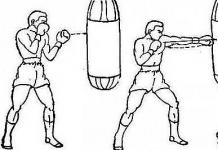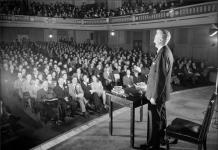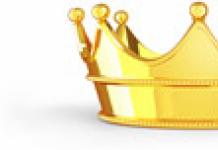Which CIA agents carried out with the help of a specialist in the field of “remote surveillance”. This term originated from Project Stargate, which was conducted by the Central Intelligence Agency in collaboration with the US Army. The project involved the use of people with paranormal abilities in the interests of national security. One of these specialists was the artist and parapsychologist Ingo Swann.
- Artist, psychic and pioneer of remote viewing technology Ingo Swann
The American Stargate project was launched in the 1970s after the CIA announced that the USSR was spending up to 60 million rubles a year on research in the field of psychotronics. This conclusion was made based on a book by two Canadian journalists, Sheila Ostrander and Lynn Schroeder, who visited the Soviet Union in the early 1970s. The authors continue to publish books on parapsychology to this day.
The organizers and participants of the Stargate project were located at Fort Meade in Maryland, they were led by Major General Albert Stubblebine and his assistant, Lieutenant Frederick Atwater. Both are former adherents of the New Age philosophical and religious movement. As a scientific director, the military brought to the project a physicist from the Stanford Research Institute, who was also a US naval intelligence reserve officer.
Almost three decades later, the CIA came to the conclusion that the Stargate program did not produce any significant results, and its leaders were suspected of adjusting data from various experiments to suit the assigned tasks. Among these leaders was Harold Puthoff, whose experiments yielded results only when Swann was the psychic on the project. Repeated attempts by CIA agents to obtain any truly useful intelligence information yielded no results, the conclusion said. However, Swann and Puthoff willingly shared with the agents their observations of distant planets and civilizations lost in space and time.
It was later revealed that physicist Harold Puthoff, who by his own claims also had the gift of "remote viewing", acquired it after achieving the highest rank of enlightenment, OT VII, in the Church of Scientology. Ingo Swann, who was expelled from the American Association of Parapsychologists ASPR in 1972 for collaborating with Scientologists, was also a member of the church. A year later, under the leadership of Puthoff, he would become one of the leading psychics of the Stargate project.
Some intelligence experts argued that the actions of Puthoff and Swann were part of the so-called Operation White Snow, in which the Church of Scientology intended to infiltrate about 5 thousand of its agents into various government agencies, including the ranks of the US armed forces.

- Still from the film “Crazy Special Forces” (“People Who Stare at Goats”), 2009.
British journalist Jon Ronson subsequently wrote a book about the project called “The men who stare at goats,” which was filmed twice—as a documentary and a feature film.
There are numerous records of UFO sightings in declassified CIA files. Thus, as part of the Stargate program in the early 1970s, American intelligence officers, with the help of the legendary psychic Ingo Swann, tried to find out what was happening on the planet Jupiter. This was reported by the Russian Dialogue publication.

13 pages talk about Swann's experiment, with the help of the power of thought he finds himself on the planet Jupiter. The document is dated April 27, 1973.
ʺIn the space to the right of this room I see Jupiter, many millions of miles away. I see how it glows with a blinding light. I am sure that ordinary vision is not capable of seeing what I observe internally. I can look in all directions with my mind's eye. At first I see everything in miniature, and then everything gets bigger,” Swann describes his feelings.

According to Swann, Jupiter is a gaseous mass of different colors, in which elements beyond the comprehension of a psychic are involved.
ʺ I see ice crystals. They hang in the atmosphere like trillions of silver needles, some near the surface,” said the psychic.
It was previously noted that in the USSR they were brought up to read the thoughts of foreign politicians.
The study of parapsychology in the USSR began in the late 50s, and only in the late 70s did the country admit that telepaths and psychics were being trained in the country. By that time, there were more than 30 centers for the study of paranormal phenomena in the USSR.

Previously, the CIA admitted that the United States was far behind the USSR in the development of psychic abilities, but after the collapse of the superpower, leadership again returned to the Americans.
Someone can draw a masterpiece blindfolded in a matter of seconds, others can calculate polysyllabic numbers in their minds no worse than a computer, someone has a phenomenal memory... There are many people in the world who amaze with their supernatural abilities. Science has been studying these abilities for decades, although these results are not always accepted by the scientific community. The article provides some examples that will make you wonder and wonder: are these real people?
Ingo Svan - a man who sees at a distance
This person can describe a remote geographical feature located hundreds of thousands of kilometers away. Moreover, he is not alone in his ability, there are other examples of people with the same unique abilities, and this is a proven fact. Scientists at Stanford University (according to some sources, together with the CIA) conducted scientific research into parapsychological phenomena, including remote viewing, that lasted more than two decades. In these experiments, several individuals were given the opportunity to describe various objects that were located in another room and in other distant places. According to a publication in the journal Scientific Research, one of the study participants, Ingo Swan, was able to successfully describe the appearance of a ring around Jupiter, the existence of which at that time could not be known to scientists. Ingo went further: he managed to describe the surface of the Moon. The intelligence services were particularly interested in remote viewing of objects, which is why the experiments aroused such interest and required large financial expenditures. Who knows how much more information remains hidden from us? 
Uri Geller. What is psychokinesis?
Another amazing example is the work of aerospace engineer and physicist Jack Hawk. In collaboration with Army Colonel J.B. Alexander, he was responsible for conducting a series of sessions whose purpose was to explore the real possibilities of psychokinesis (moving objects with the power of thought). Experiments were carried out using various metal objects. The subjects were able to bend or deform the samples without physical effort. There are also reports of people (mostly children) who had the ability to teleport, that is, instantly move from one place to another. One of the subjects was the psychic Uri Geller, who during a conversation bent a spoon without touching it. One may doubt, think that this is a hoax, but what Uri Geller demonstrated is a reliable fact. What is certain is that consciousness has some measurable influence on our physical material world, and the arguments in favor of this claim are already firmly established in the scientific literature.
Stephen Wiltshire - autistic genius
 He was diagnosed with autism at age 3. He is an artist who paints detailed cityscapes. He is widely known for his ability to observe precise representations of cities in just a few seconds and then depict them with extraordinary accuracy. All his paintings were painted from memory.
He was diagnosed with autism at age 3. He is an artist who paints detailed cityscapes. He is widely known for his ability to observe precise representations of cities in just a few seconds and then depict them with extraordinary accuracy. All his paintings were painted from memory.
Wim Hof - "Ice Man"
 Wim Hof amazed many scientists with the fact that he could meditate while remaining immersed in ice for almost two hours. At the same time, his body temperature remained virtually unchanged. This is amazing, and it also gives the world evidence of the huge role consciousness plays, so much so that the reaction in our body to certain situations and ailments can depend on it. After Wim successfully passed the test and proved that he could maintain body temperature in such harsh conditions, he moved on. The solution was: climb Everest in just underpants, fight off altitude sickness, then complete your marathon in the Namib Desert without water. And he carried out his plans. Wim Hof has set similar records more than once. Scientists have confirmed and proven in laboratory conditions that he is able to regulate his autonomic nervous system and immune system at will. Of course, all this is considered impossible for most people.
Wim Hof amazed many scientists with the fact that he could meditate while remaining immersed in ice for almost two hours. At the same time, his body temperature remained virtually unchanged. This is amazing, and it also gives the world evidence of the huge role consciousness plays, so much so that the reaction in our body to certain situations and ailments can depend on it. After Wim successfully passed the test and proved that he could maintain body temperature in such harsh conditions, he moved on. The solution was: climb Everest in just underpants, fight off altitude sickness, then complete your marathon in the Namib Desert without water. And he carried out his plans. Wim Hof has set similar records more than once. Scientists have confirmed and proven in laboratory conditions that he is able to regulate his autonomic nervous system and immune system at will. Of course, all this is considered impossible for most people.
Secrets of Buddhist monks
 While in remote monasteries in the 1980s, Harvard medical professor Herbert Benson and his team of researchers studied monks living in the Himalayan mountains who could raise the temperature of their fingers and toes by as much as 17 degrees. It is still not known how the monks are able to generate such heat. The researchers did not stop there; they continued to study enlightened meditators in Sikkim (India). Once again, scientists were amazed when they were shown how monks could reduce metabolism by 64%. In 1985, a Harvard research team made a video of monks instantly drying cold, wet sheets with their body heat. Such miracles are not uncommon. How do monks survive on winter nights in light robes in the Himalayas, at an altitude of 15,000 feet? Maybe yoga, meditation and other similar practices reveal the supernatural psychic abilities inherent in humans?
While in remote monasteries in the 1980s, Harvard medical professor Herbert Benson and his team of researchers studied monks living in the Himalayan mountains who could raise the temperature of their fingers and toes by as much as 17 degrees. It is still not known how the monks are able to generate such heat. The researchers did not stop there; they continued to study enlightened meditators in Sikkim (India). Once again, scientists were amazed when they were shown how monks could reduce metabolism by 64%. In 1985, a Harvard research team made a video of monks instantly drying cold, wet sheets with their body heat. Such miracles are not uncommon. How do monks survive on winter nights in light robes in the Himalayas, at an altitude of 15,000 feet? Maybe yoga, meditation and other similar practices reveal the supernatural psychic abilities inherent in humans?
Daniel Tammet - life in numbers
 In 2004, this guy attracted a lot of public attention by reciting the mathematical constant Pi (3.141...) from memory: in 22,414 decimal places. This went on for 5 hours and 9 minutes and he didn't make a single mistake. The reading took place at the History of Science Museum in Oxford. Daniel set a European record.
In 2004, this guy attracted a lot of public attention by reciting the mathematical constant Pi (3.141...) from memory: in 22,414 decimal places. This went on for 5 hours and 9 minutes and he didn't make a single mistake. The reading took place at the History of Science Museum in Oxford. Daniel set a European record.
At the age of 4, he was diagnosed with autism after a severe epileptic seizure. However, he is capable of performing a number of complex psychological tasks and learning a course of mathematics that is inaccessible to any “normal” mind. This is common among autistic people, and Daniel himself emphasizes that the differences between the learned and unlearned minds that mainstream medicine states are too illusory. According to him, his amazing ability is not the result of genetic quirks, but rather speaks to a very rich and complex associative form of thinking and imagination.
Yuri Pichugin psychologist, viewer, healer,coach, specialist in dance movement therapy, researcher of altered states of consciousness and their influence on human extrasensory abilities, project manager "ExtraVision",winner of the All-Russian Exhibition Center gold medal,Member of the International Remote Viewing Association.
He has been working on this topic for about 20 years, the creator of a method for obtaining extrasensory information through simultaneous synthesis, the creator of a method for interpreting photographic symbols, and the author of the book “The Secret Language of Our Photographs.”
Since 2004 he has been practicing Remote Viewing. The first and only person in Russia who was trained in the USA directly from the creators of this method: Russell Targ, from the number 1 judge in the USA Joseph McMoneagle, from one of the leading trainers and one of the main participants of “StarGate” Leonard Buchanan, from Laurie Williams and Talia Shafir, chief assistant to the head of the StarGate project;
VISION CLASSIFIED SECRET
OR THE VELVET REVOLUTION OF CONSCIOUSNESS
The plant let out a scream. Of course, it was a scream that was recorded only by the electronic recorders of the polygraph connected to it. But the fact remained that the Dracaena Massanga plant reacted with a sharp surge in physiological activity to the thoughts of a person who imagined that it would harm him. This man was Ingo Swann, a New York artist. He was invited to his laboratory on Broadway by Cleve Baxter, one of the leading American and world experts in the field of polygraph (lie detector) application, to conduct telepathy experiments with plants.
The experiment itself consisted of the following. Ingo Swann, having entered a room with a plant on which there were sensors, had to begin to imagine that he would now bring a match to one of the leaves of the plant and begin to burn it. And.. oh my God! The plant reacted to human thoughts with a violent surge of physiological activity. The splash was so violent, and the polygraph needle jumped so high that the device clearly went off scale. Cleve Baxter asked the artist to think more and more about offering a burning match. The plant continued to react to this with the same burst, but over time these bursts became more and more moderate until they completely disappeared.
- What does it mean!? - Ingo Swann said in bewilderment - does this mean that it realized that I was playing a prank on him and was not really going to burn him? The plant clearly exhibited what is commonly called a learning curve.
In response to this question, Cleve suggested that he continue and take another type of plant-damaging ideas. Then Ingo Swann imagined that he was pouring acid on the plant, and the burst of polygraph activity repeated with renewed vigor. However, as a result, this harmful thought created almost the same learning curve. Over time, the plant again learned to understand that the threat was not real.
All this happened in September 1971. This was the time when the unemployed artist Inogo Swann, wandering from one laboratory to another, became the object and subject of various, increasingly unexpected for him, parapsychological experiments. In addition to experiments with plants at the Cleve Baxter Laboratory, he participated in experiments of the American Society for Parapsychological Research, where he became a subject in a series of experiments on the perception of objects hidden from him through out-of-body experiences. The success of these experiments brought him some fame in circles involved in the study of parapsychological phenomena. In particular, he was invited by Gertrude Schmeidley, who heads the City College laboratory, to conduct experiments on psychokinetic effects on thermistors. After Ingo Swann began to focus on the thermistor, a telekinetic change in the temperature of the thermistor was detected, thus turning it on. The whole series of successful experiments carried out by the New York artist in various laboratories earned him the reputation of a man capable of much.
Meanwhile, physicist Harold Puthoff, a well-known specialist in the field of laser electronics, became interested in the telekinetic abilities of the Other Swann. He invited Ingo to the Stanford Research Institute, a division of the world-famous Stanford University in California, to conduct research. It was decided to conduct the first experiment with Ingo Swann in order to study its possibility of influencing the operation of precision equipment. This was an experiment with a magnetometer located in one of the Stanford laboratories. At that time, the magnetometer was the most accurate instrument in the world for detecting quarks, then (in 1972), hypothetical particles. It was a very expensive high-tech device and was famous for its protection from even the most insignificant external influences. This device had several degrees of protection: it was enclosed in an aluminum container, surrounded by a copper electrostatic shell and also had a layer of protection from a superconducting shell. At the same time, he was surrounded by a thick layer of concrete and buried in the ground at a depth of one and a half meters from the floor surface. Thus, it was assumed that this device could not be disturbed from the outside.
And so Hall Puthoff decided to invite Ingo Swann to try to psychokinetically influence the readings of the magnetometer in order to deflect the needle, which had been stationary for many years in anticipation of the appearance of hypothetical quarks, which had not yet appeared. The scientific elite at Stanford gathered to observe the progress of this experiment, of course deeply skeptical about the existence of such effects.
When Puthoff and Swann arrived at the laboratory, where the magnetometer display was located, the entire audience was already assembled. After introducing Swann's Other to the Stanford scientific elite and describing the objectives of the experiment, Hall Puthoff suggested that Swann disturb the magnetometer.
"Where is he?" asked Swann. “It’s underground, shielded with a superconducting shell,” Puthoff replied. “I would like to start by looking inside it,” said Swann and decided to start by simply “getting acquainted” with the device by plunging my mind’s eye into the place deep into the earth under the floor where the magentometer was. At the same time, according to him, he has not yet set the task of influencing him. But as soon as he tried to direct his attention to the magnetometer, surprised exclamations were heard from the surrounding public: the needle of the magnetometer, which had been dead “silent” for several years, suddenly demonstrated a sudden significant deviation from zero. Ingo Swann himself was amazed, since he himself did not expect such an effect, and the deviation of the needle occurred even before he tried to make a real attempt to influence the magnetometer.
When Puthoff asked what he did, Swann replied that he only looked at the device. “Look again,” he asked him. And Ingo did the same again. The arrow deviated again. Observing all this, the laboratory assistant, who was responsible for the serviceability of the device, suddenly exclaimed: “Stop, something is wrong with my device,” and he began to fuss, believing that the device was faulty. Not really understanding what was happening, Ingo Swann did the same thing several times in front of the amazed public and each time he managed to change the readings of the device. The audience was silent in fascination.
Subsequently, Puthoff proposed an explanation for this effect. He believes that the quantum mechanical effect of the presence of the observer in the experiment affected the deflection of the needle. Based on the famous Heisenberg uncertainty relation, the very fact of observing the device seems to fix its position in space, thereby leaving uncertainty in the momentum, which could manifest itself in the deflection of the needle. Probably, as always, there are many versions that fit the theory to such experiments. But perhaps this is not what is decisive in this case - what is decisive is the very ability of a person to influence remotely on objects of inanimate nature.
Chapter 2. Trouble in the Pentagon or clairvoyants in uniform
Two weeks after this experiment, people from the CIA approached Puthoff and offered cooperation in the development of parapsychological topics. They explained that this idea originated in the bowels of the intelligence agency because there was a leak of information from the Soviet Union, indicating that the Soviets were quite intensively secretly studying parapsychological phenomena and the possibility of their use for military purposes. It became known that they spend millions of dollars a year on research on this topic, attracting the best specialists from various fields of science. All this quite alarmed and confused the leadership of the CIA and the defense department. Indeed, in American scientific and military circles at that time no one even seriously considered the very existence of these phenomena themselves, much less any of their practical applications. That is why Harold Puthoff, a laser physicist with an impeccable reputation and the authority of a serious researcher, received an offer to head this rather unusual secret project related to parapsychology. The CIA people said they weren't interested in psychokinesis - they were interested in Remote Viewing. Of course, the American intelligence services were primarily interested in everything that could provide at least some opportunity to obtain information about secret Soviet military facilities.
People from the CIA turned to Puthoff with a request to demonstrate to them in practice the possibility of Remote Perception of Objects. Puthoff, in turn, asked Ingo Swann to do this and he agreed. The CIA agents spent a couple of days preparing various envelopes and boxes with hidden purposes for perception. In the first experiment, Ingo was asked to describe what was in a sealed envelope. He said that what he sees is like a leaf, but this leaf is moving. It turned out that it was a butterfly, and Swann described its contours quite accurately, while mistakenly calling it a leaf. In general, Ingo Swann showed high test results and then experiments were carried out with another clairvoyant, Hela Hemet. After a series of these experiments, the CIA leadership gave the green light to the first project in this area, still with a small budget of 50 thousand dollars. Its main organizers were Hal Puthoff and his colleague Russell Targ. Thus was born what was called Remote Viewing. A series of experiments began with sealed envelopes, with boxes containing various objects, into which the all-seeing gaze of the viewer was supposed to penetrate (the viewer is a person capable of Remote Vision from the English view - to look at). However, during one of these experiments, Ingo Swann said: “As long as you can open the boxes, let’s open the doors!” A self-confident, unemployed artist offered to go beyond the walls of the laboratory and assured that he was able to see everything on Earth at any point, and not only on Earth, but also in space. And so, during one coffee break, as if as a joke, it was decided to try to “go outside the laboratory” in order to then return to the continuation of “serious experiments”. One of the employees visited a place located some distance from the laboratory. No one except him knew what this place was, and there he made a sketch of what he saw around him. Ingo, being in the laboratory at that time, also made a sketch of what this man saw during the coffee break. When he returned, the drawings of Ingo and the employee leaving the laboratory were compared, and everyone who saw them was forced to admit that they corresponded very well to each other. The project curators from the CIA were very encouraged when they learned about the positive results of the experiments taking place outside the doors of the laboratory. Since then, similar working methods have become widely used in the Remote Vision laboratory. Other psychics were also involved in experiments in the laboratory. Interesting results were obtained in one experiment with Pad Price. The experiment consisted of a CIA agent taking off in a plane, and Pad made sketches of what the pilot saw below him. As a result, Price described what he saw as a complex of water pools and it really corresponded to reality. When asked what kind of place he thinks he sees, he replied that it seems to him that he perceives a water treatment plant. He also described seeing a water purification plant next to the marked pools. But in reality this installation did not exist in that place. In addition, he said that he saw two more large water tanks nearby. They, too, of course, were absent from the place he indicated. This information appeared to be a mixture of real and imaginary information, a phenomenon that occurred quite often in similar experiments. However, Russell Targ turned to the district archives of Palo Alta - the area in which all this took place - and received information that a water treatment plant actually existed in the indicated location several decades ago and the location of the equipment on its territory was indicated by Pad Price absolutely correctly .
Scientists and doctors, actually seeing that a group of psychic viewers were performing miracles, decided to study them in order to establish the difference between such people and “ordinary” people. When they did a tomography of the brain, it turned out that its structure was absolutely no different from the normal human one. Then they decided that perhaps there were some differences in their psyches. A series of thorough psychological tests were conducted, after which more was known about them than NASA learns about astronauts before flying into space. But at the same time, no features were found either. These people were completely normal.
When the results of the first, such successful experiments on the perception of remote information were reported to the leadership of the CIA, they treated them with suspicion. And even suspected scientists of falsifying facts. Therefore, the CIA decided to send its observer to the laboratory, who would expose the fraud and appointed the most inveterate skeptic to this position, who showed up at the laboratory with the words: “I have come to expose exactly how you are defaming”!
He asked to do the experiment directly in front of him. Everything was done exactly as before. Puthoff and the CIA agent went outside the walls of the laboratory to a randomly chosen place and when they returned, the viewer described this place with amazing accuracy. To which the CIA observer laughed and did not believe it: “Yes, you apparently told him all this a minute ago.” Then he added that now, in the next experiment, he himself will set the picture for the viewer’s perception. Once again the report was excellent. However, the agent muttered under his breath that somewhere he was being fooled here. In the next experiment, he suggested setting a picture to describe the viewer while sitting on his machine. Together with Puthoff, they arrived at the place he had chosen and, according to the conditions of the experiment, they had to stand there for half an hour. However, after fifteen minutes, the agent suddenly demanded that they move the car to another location. Puthoff tried to object, saying that according to the conditions of the experiment, it should last half an hour, but the whistleblower was adamant and they moved to another place. At the very moment when they began to move to another place, the viewer who was in the laboratory looked at his watch in surprise and said: “Oh, not even fifteen minutes have passed and they have already taken the car and moved to another place.” And he also described the second place in detail, as well as the first. And still the agent said: “I know this is a scam, let’s do another experiment.” Puthoff and Targ realized that they could prove to this agent the honesty of their experiment only if he himself tried to act as a viewer. After all, to one degree or another, every person has the ability to remotely view. And in the morning they invited the CIA commissioner to play the role of a test subject himself. At first he was very surprised and said he wouldn't do it because he didn't even believe it existed. But they still convinced him. Puthoff and his colleague went to the appropriate place, and Rasel Targ remained next to the agent to help him perceive what was happening at a distance from him. Targ asked the subject to close his eyes and describe what he saw. He said that he had already closed his eyes, but saw only darkness. To this Targ asked to turn on his imagination and give it free rein. “Oh,” he exclaimed, “of course I can imagine a lot, well, for example, I see a bridge across the river, if you are interested in my imagination. What does all this have to do with reality? When Puthoff and his colleague returned from the bridge over the river, which was actually the goal of the experiment, they showed him this bridge. The CIA agent was dumbfounded. However, in this case he said: “No, I still know that this is a fraud.” "How?" - they exclaimed, “You yourself, you just did it!” But he replied: “I know how you set it up. Let's do another experiment with me as a viewer." Fine. He was left alone in the laboratory room and carefully closed the door so that no one could enter it. When, after visiting the target location, they returned to the room, the agent was sitting in the corner of the room, covering his ears with his hands. The target report was on the table and was quite accurate. Puthoff asked him why he was sitting in the corner with his hands over his ears? The agent replied that he had two hypotheses about the method of our fraud. The first is that in the first experiment with him as a viewer, Russell Targ, making movements with his hands, inspired him with the necessary thoughts and images of the goal. The second hypothesis is that there were hidden little speakers built into the back of the chair he was in the second time that whispered to him a description of the place, and he simply wrote it down. To all the objections about the groundlessness of his suspicions, he only replied that he now wanted to conduct a new experiment with the perception of remote areas. This time, those who will be outside the laboratory at the selected location must take photographs and tape recordings there. And upon his return, they will first provide him with these materials and only after that he will show his received report. The figure given here... shows photographs of the object perceived in this experiment and next to it are drawings of a CIA agent. These were children's carousels. The correspondence between the drawing and the target appears to be quite good, with the exception of the dome-shaped shapes, which did not exist in reality. They provided an example of analytical distortions of the perception process, which manifest themselves when the perceived primary image is subjected to secondary analytical processing in consciousness.
Still, in the end, the CIA agent was almost convinced of the reality of what was happening. When he returned to his CIA department and reported to its leadership, they almost seriously thought that he, too, had taken part in the fraud. However, in the end he managed to convince management that there was no fraud.
The experiments continued. In the process, the emphasis began to be increasingly placed on reading information about an object by specifying its geographical coordinates - latitude and longitude. One day a curious incident happened. Hella Hemet gave two viewers Pad Price and Ingo Swann the coordinates of the target, which was a holiday village. They began to describe the area, saying that they saw country houses, forests, etc. there. But they didn’t know that there was a super-secret military facility located just over the hill in this area. And both of them said, having perceived it: “Oh, this must be what we need to describe.” So, Ingo gave a description of the structure of this object, and Pad Price, clearly impressed by what he saw, even gave a description of the names of the signs on the doors. Then he explained that these names simply appeared in his head as whole words. The CIA subsequently wrote this in a report on this experiment: “Pad Price gave a list of words almost exactly reproducing the names of past and present military actions. He also reproduced the code name for this place.” You can imagine what began in the apparatus of the department to which this secret facility belonged. The boss had a question: where did the secret information that was given in the report come from? The answer was that it was obtained through “Remote viewing”. To which the chief replied something along the lines of “don’t let people fool him,” but rather find the link where the leak came from.
As a result, a proposal was received from the then CIA chief: If viewers can perceive information so well, then why not try to get information about a Soviet secret facility. The viewer, which in this case was Pad Price, was given only the coordinates of the object in the form of latitude and longitude. He described the entire area and at the end he said that he saw just a huge crane several floors high, rolling over the buildings. The crane is so high that a person standing next to it at full height reaches only half the height of its wheel. Pad Price was very confused by what he saw and added that it all looked like science fiction. He began to apologize for what he saw. However, this is what the place he described actually looked like. There was a giant crane and buildings that it rode over and a man next to the crane.
Chapter 3. Remote Viewing – the first sign of humanity’s evolutionary leap?
It has happened more than once in history that the insatiable appetites of the military in the field of gaining superiority over the enemy gave rise to the most daring projects in the field of science and its rapid implementation into practice. The most striking example of this is the creation of nuclear weapons and the study of the microworld as a whole. The same story happened with the assault on the deepest resources of the human psyche. And we must admit that the first worthy breakthrough (but apparently not the last) in this area was carried out precisely by the American military and intelligence services during a series of projects between 1972 and 1996, when Remote Viewing was born. But we must also recognize the fact that the American intelligence services, of course, also used the experience accumulated by other intelligence services in this area. It is known that during the creation of the RV, the Americans actively used the experience of Czech, Chinese, Soviet, German, Israeli and even British intelligence services. The most interesting thing is that all these studies were based on very unusual for their time programs launched during the Second World War by Nazi Germany. It is widely believed that after the fall of the Third Reich, the Soviet Union took possession of the documents of the famous Nazi Occult Bureau. Other documents became partially or completely the property of Allied intelligence services, which then decided whether to continue to study this in subsequent years or completely ignore the potential of this research. Before American intelligence agencies began studying paraphenomena in 1972, they were faced with the question: Does the United States have this kind of information? And it had to be admitted that they did not have this potential at that time and did not even seriously consider such possibilities. (At the end of 1972, the scientist Sidney Gottlieb, the head of the CIA division, secured the allocation of money so that the US could start a project to study and create radioactive missiles. The fact is that if the Soviet Union really led in this area, then the United States could be are in serious danger). Thus began a project at the Stanford Research Institute led by serious physicists Russell Targ and Harold Puthoff. And at the beginning of the project, much attention was paid to the very fact of the existence of phenomena. And it was proven that Yes! It exists. Not 100% accurate and it has its limitations. But the truth is that while one can figure out the accuracy of the technology, another can use it to obtain pieces of missing information! Therefore, the CIA received at its disposal a new technology for obtaining classified information: psychic espionage. Having initially started as a program within the CIA, the project was later transferred to the military department under the code name Flame of the Grill. It was devoted to studying how vulnerable the American intelligence services are to psychic espionage. This work was done so well and accurately that the Army decided to shift its focus from simply assessing vulnerability to obtaining information about US adversaries in the Cold War. Unfortunately, but quite expectedly, the viewers also had their detractors among the military such as Major Bill Odom, Lieutenant General Harry Soyster, high-level bureaucrats in the Defense Department and the CIA, and politicians inside the White House and Congress.
One cannot but agree that Remote Viewing was not just a project to spy on military targets of a potential enemy or other similar narrowly utilitarian purposes. No, behind all this screen of generals’ fuss was hidden a truly global and revolutionary breakthrough for humanity as a whole, even surpassing, I am sure, the breakthrough of science during the creation of the nuclear bomb and quantum mechanics. We cannot even yet appreciate it, since its fruits are still faintly visible, and the sown seeds have not yet had time to germinate. It must be admitted that the main merit of this project is that it has been proven that the entire human race has the ability to receive extrasensory information. Now it has become obvious that these abilities are not the privilege of individual clairvoyants, but are available to all people. Talented mediums are only a kind of volcanoes, erupting to the surface those deep layers of abilities that are hidden within human nature, and therefore accessible to everyone. And Remote Viewing technology became the first formalized procedure consistently leading to results. It has become possible to teach this to any person of average ability. This means that a genuine leap in the development of humanity is just around the corner. And this, of course, will be achieved by the creation of more advanced psychotechnologies in this area. The first technology that we now have, of course, does not yet fully satisfy the requirement of accuracy and reliability. But already at this stage, for some viewers, the accuracy of obtaining information sometimes reaches 90 percent or more, which is a very good result, especially for the initial period of development of the method. The situation here, I think, is reminiscent of the development of the computer field. In the beginning, we had bulky, room-sized computers, “UES-ki” or similar computers, which often froze, crashed, and could even make mistakes. They were replaced by more advanced personal computers and made a global revolution in the world. I'm sure something similar awaits us here. We can assume that today we already have Remote Viewing in the role of “UES-ki”.
Another point is clear: the revolution occurred not only in the field of discovery and application of the ability to perceive information. There has been a revolution in the awareness of who we are in the universe and how this world as a whole works. Probably we still have to comprehend and bring a more advanced theory to everything that we observe in Remote Viewing, and most likely we will have to create a fundamentally new concept of reality, somehow taking into account the fact that a person is in some incomprehensible way connected to the universal universal information matrix.
(To be continued)
I myself have been researching this area for about 20 years and, paradoxically, at times my findings essentially coincided with those that I discovered in the RT method. This, of course, can most likely be explained by the fact that the information comes from a single source or is stored in one place, from where everyone can receive it if desired. Although I admit that this topic came into my life quite unexpectedly.
Chapter 4. First personal experience of telepathy
I had my first experience of consciously receiving supersensible information in the mid-80s. Then, according to tradition, all issues were resolved in the kitchens. And then, on one of the long winter evenings, when we were chatting late into the night with one of my friends in the kitchen, we somehow got the idea to telepathically transmit images to each other. I must admit that this arose more like pampering and, of course, none of us expected any result. It is possible that the ease and irresponsibility with which we did this, and the very late hour, when consciousness was already clouded (about 2 or 3 a.m.), were also apparently significant at that moment for the result obtained. And he was really very unexpected for us then.
The experience consisted of us taking turns trying to convey two categories of images to each other. One category was the images of our imagination, and the second category were the images of objects that we ourselves chose in the room for telepathic transmission. Of course, it’s easier for me to describe what I myself perceived in this experience. I closed my eyes and after a certain “look” in the internal space I saw some vague outlines of objects somewhat reminiscent of x-rays. These were black and white images, not similar to images from dreams or fantasy images, they also were not like afterimages of objects that surround us and remain in the inner field of vision after we close our eyes. It was something special. As I later found out, this is the form in which many views perceive information. This is how information coming from the subconscious is displayed, and it, in turn, receives it from the universal matrix with which it is connected. But I will say more about this a little later.
My first experience of telepathy in the kitchen simply shocked me. I could not believe my eyes, if only these words are applicable to the modality of internal perception. Of course, I had heard before about some people who could do this - there were legends about Wang, I read something about other clairvoyants, I heard about the miracles of Indian yogis, but it all seemed very far away, and even doubtful. It seemed that in order for something like this to happen, either years of training, fasting, sitting in a cave, etc. were necessary, or it had to be some kind of phenomenal gift from nature. But my friend and I both managed to do it. Does this really mean that these abilities are very close and everyone has them?
I started doing the same experiment with other people. The result was also positive. Naturally, this was far from a 100% hit, but the shapes of the objects perceived by me quite often coincided with the shapes of the transmitted objects. Already in these first experiments, some regularities became noticeable. It turned out to be curious that sometimes I perceived not only the object itself on which a person was concentrating his attention, but also objects located next to him or behind him. This means that it was possible to conclude that it seems that it was not the object that was being transmitted as an abstract thought about it, but that it was the entire field of view of the “translator” that was being transmitted completely. And one more point that remained completely mysterious, and even now, I must admit, I only have a hypothesis explaining this. The point is that when transmitting images, they reached me symmetrically reflected relative to the vertical axis - i.e. everything that the person transmitting saw in his field of vision on the right, I saw on the left and vice versa. Later I put forward a hypothesis to explain this. Apparently the point is that with this kind of perception, our subconscious, thinking about a person, completely bypassing our consciousness, turns him, as it were, to face himself, or at least his image. And only then he perceives images of objects that he reads from the internal reality or the subtle body in which they are imprinted at that moment. But since we see the person in a mirror position, then a symmetrical reflection appears, giving a similar effect.
It became clear that the process of telepathy does not depend on distance, so when talking on the phone with a person from another city, I also had the opportunity to “read” his images.
What’s interesting is that later, many years later, I did the same experiment with my child, who was three and a half years old at that time. The results were even more amazing to me.
This time, to conduct an experiment, I took a book with pictures that was unfamiliar to him and, opening a random page, asked him to describe what I was looking at there. To my great surprise, he described what I see in the picture without even closing his eyes. The accuracy was also impressive. Slightly dumbfounded, I took a box of toys and began to take small toys that fit in my fist from children's Kinder Surprises and also asked me to describe what was hidden in my fist. His answers here were impressive in their accuracy. But, however, he stopped at some next toy and said, for some reason, that he didn’t want to do this anymore. I didn't insist. Everything was already obvious.
I understand that by talking about such an experiment with a 3.5-year-old child, I am not discovering America - it’s likely that many have heard about children’s “genius” in this sense. However, I would like to try to elaborate on the possible reasons for this. After all, this understanding will give a lot to us adults. And the important thing in such a child’s perception is that the child does not know that he is doing something out of the ordinary or something congenial. He is still completely devoid of self-assertion to prove anything, there is no tension in him awaiting punishment for failure. And even more so, he is unaware of what has already been hammered into the brains of many adults, that telepathy is impossible, or at least very unlikely. The slightest punishment for failure also reduces the productivity of this subtle process. Moreover, punishment for adults can exist not only in various forms of external manifestations - disapproval from others or something similar, but also internal ones - decreased self-esteem, decreased mood, etc. There is another factor that works against adults here. Over time, the consciousness of an adult becomes more and more oriented towards the perception of external reality. Our culture treats subtle perceptions of the inner plane with ridicule. This is obvious from phrases like: Seems - you need to be baptized, imagined, imagined - all these and similar words have in our language a fair amount of irony, ridicule and mistrust. Namely, they are the most adequate for describing the processes of perception of subtle internal reality. From such a frivolous and mocking attitude towards these words, the conclusion follows that in our mentality there is a certain tendency to suppress the perception of internal processes, push them aside as inferior, and thus separate a person from himself and his reality. Indeed, in our culture it is not very common to turn to your intuition for help. We are taught to make our decisions based on anything - on the opinions of others, on our past experience, on the wisdom of centuries - but not on our intuition and our subtle plan. As a result of such “repression” of subtle reality, we, unlike young children, lose contact with our depths and come to a certain conflict between internal and external realities.
(This part is to be continued)
...The plant let out a scream. Of course, it was a scream that was recorded only by the electronic recorders of the polygraph connected to him. But the fact remained: the Dracaena Massanja plant reacted with a sharp surge in physiological activity to the thoughts of a person who imagined that he would harm him. This man was Ingo Swann, a New York artist. He was invited to his laboratory on Broadway by Clive Baxter, one of the leading American and world experts in the use of the polygraph (lie detector), to conduct experiments on telepathy with plants.
The experiment itself consisted of the following. Ingo Swann, having entered a room with a plant on which there were sensors, had to begin to imagine that he would now bring a match to one of the leaves of the plant and begin to burn it. And... Oh God! The plant reacted to human thoughts with a violent surge of physiological activity. The splash was so powerful that the polygraph needle clearly went off scale. Baxter asked the artist to think more and more about offering a burning match. The plant continued to react to this with the same burst, but over time these bursts became more and more moderate until they completely disappeared.
- What does it mean? - Ingo Swann said in bewilderment. “Did it realize that I was playing a trick on it and that I wasn’t really going to burn it?” The plant clearly exhibited what is commonly called a “learning curve.”
In response to this question, Clive suggested that he continue and take another type of plant-damaging ideas. Then Ingo Swann imagined that he was pouring acid on the plant, and the burst of polygraph activity repeated with renewed vigor. However, this harmful thought resulted in almost the same learning curve. Over time, the plant again learned to understand that the threat was not real.
All this happened in September 1971. This was the time when the unemployed artist Ingo Swann, wandering from one laboratory to another, became the object and subject of various, increasingly unexpected for him, parapsychological experiments.
In addition to his experiments with plants in Baxter's laboratory, he participated in experiments of the American Society for Parapsychological Research, where he became a subject in a series of experiments on the perception of objects hidden from him through out-of-body experiences. The success of these experiments brought him some fame in circles involved in the study of parapsychic phenomena.
He was also invited by Gertrude Schmeidley, who heads the City College laboratory to conduct experiments on psychokinetic effects on thermistors. After Ingo Swann began to focus on the thermistor, a telekinetic change in the temperature of the thermistor was detected, thus turning it on.
The whole series of successful experiments carried out by the New York artist in various laboratories earned him the reputation of a man capable of much.
Meanwhile, physicist Harold Puthoff, a well-known specialist in the field of laser electronics, became interested in Ingo Swann's telekinetic abilities. He invited Ingo to the Stanford Research Institute, a division of the world-famous Stanford University in California, to conduct research.
It was decided to conduct the first experiment with Ingo Swann in order to study its possibility of influencing the operation of precision equipment. This was an experiment with a magnetometer located in one of the Stanford laboratories. At that time, the magnetometer was the most accurate instrument in the world for detecting quarks, then (in 1972) hypothetical particles. It was a very expensive high-tech device and was famous for its protection from any, even the most insignificant, external influences. This device had several degrees of protection: it was enclosed in an aluminum container, surrounded by a copper electrostatic shell and also had a layer of protection from a superconducting shell. At the same time, he was surrounded by a thick layer of concrete and buried in the ground at a depth of one and a half meters from the floor surface. Thus, it was assumed that this device could not be disturbed from the outside.
And so Hall Puthoff decided to invite Ingo Swann to try to psychokinetically influence the readings of the magnetometer in order to deflect the needle, which had been stationary for many years in anticipation of the appearance of hypothetical quarks, which had not yet appeared. The scientific elite at Stanford gathered to observe the progress of this experiment, of course, deeply skeptical about the existence of such effects.
When Puthoff and Swann arrived at the laboratory, where the magnetometer display was located, the entire audience was already assembled. After introducing Ingo Swann to the Stanford scientific elite and describing the objectives of the experiment, Hall Puthoff suggested that Swann disturb the magnetometer.
"Where is he?" - asked Swann. “It's underground, shielded by a superconducting shell,” Puthoff replied. “I would like to first look inside it,” said Swann and decided to start by simply familiarizing himself with the device, plunging my mind’s eye into the place under the floor where the magnetometer was. At the same time, according to him, he has not yet set the task of influencing him. But as soon as he tried to direct his attention to the magnetometer, surprised exclamations were heard from the surrounding public: the needle of the magnetometer, which had been dead silent for several years, suddenly demonstrated a sudden significant deviation from zero. Ingo Swann himself was amazed, since he himself did not expect such an effect, and the deflection of the needle occurred even before he tried to make a real attempt to influence the magnetometer.
When Puthoff asked what he did, Swann replied that he only looked at the device. “Look again,” he asked him. And Ingo did the same again. The arrow deviated again.
Observing all this, the laboratory assistant, who was responsible for the serviceability of the device, suddenly exclaimed: “Stop, something is wrong with my device!” And he began to fuss, believing that the device was faulty. Not really understanding what was happening, Ingo Swann did the same thing several times in front of the amazed public and each time he managed to change the readings of the device. The audience was silent in fascination...
Puthoff subsequently proposed an explanation for this effect. He believes that the quantum mechanical effect of the presence of the observer in the experiment affected the deflection of the needle. Based on the famous Heisenberg uncertainty relation, the very fact of observing the device seems to fix its position in space, thereby leaving uncertainty in the impulse, which could manifest itself in the deflection of the needle.
Probably, as always, there are many versions that fit the theory to such experiments. But perhaps this is not decisive in this case - the decisive factor is the very ability of a person to influence remotely objects of inanimate nature.
Trouble in the Pentagon, or Clairvoyants in uniform
Two weeks after this experiment, people from the CIA approached Puthoff and offered cooperation in the development of parapsychological topics. They explained that this idea originated in the bowels of the intelligence agency because there was a leak of information from the Soviet Union, indicating that the Soviets were quite intensively secretly studying parapsychological phenomena and the possibility of their use for military purposes. It became known that they spend millions of dollars a year on research on this topic, attracting the best specialists from various fields of science. All this quite alarmed and confused the leadership of the CIA and the defense department. Indeed, in American scientific and military circles at that time, no one even seriously considered the very existence of these phenomena - let alone any of their practical applications.
That is why Harold Puthoff, a laser physicist with an impeccable reputation and the authority of a serious researcher, received an offer to head this rather unusual secret project related to parapsychology. The CIA people said they weren't interested in psychokinesis - they were interested in remote viewing. Of course, the American intelligence services were primarily interested in everything that could provide at least some opportunity to obtain information about secret Soviet military facilities.
People from the CIA turned to Puthoff with a request to demonstrate to them in practice the possibility of remote perception of objects. Puthoff in turn asked Ingo Swann to do this, and he agreed.
The CIA agents spent a couple of days preparing various envelopes and boxes with hidden purposes for perception. In the first experiment, Ingo was asked to describe what was in a sealed envelope. He said that what he sees is like a leaf, but only this leaf is moving. It turned out that it was a butterfly, and Swann described its contours quite accurately, while mistakenly calling it a leaf.
In general, Ingo Swann showed high test results, and then experiments were carried out with another clairvoyant, Hela Hemet. After a series of these experiments, the CIA leadership gave the green light to the first project in this area, still with a small budget of 50 thousand dollars. Its main organizers were Hall Puthoff and his colleague Russell Targ. Thus was born what was called “Remote Viewing”.
A series of experiments began with sealed envelopes, with boxes containing various objects, into which the all-seeing gaze of the viewer was supposed to penetrate (viewer is a person capable of Remote Vision; from the English view - to examine). However, during one of these experiments, Ingo Swann said: “As long as you can open the boxes, let’s open the doors!” A self-confident, unemployed artist offered to go beyond the walls of the laboratory and assured that he was able to see everything on Earth at any point, and not only on Earth, but also in space.
And so, during one coffee break, it was decided, as if as a joke, to try to “go beyond the laboratory” and then return to continuing “serious experiments.” One of the employees visited a place located some distance from the laboratory. No one knew what this place was except him, and there he made a sketch of what he saw around him. Ingo, being in the laboratory at that time, also made a sketch of what this man saw during the coffee break. When he returned, the drawings of Ingo and the employee leaving the laboratory were compared, and everyone who saw them was forced to admit that they corresponded very well to each other. The CIA project curators were very encouraged to learn about the positive results of the experiments taking place outside the laboratory doors. Since then, similar working methods have become widely used in the Remote Vision laboratory.
Yuri Pichugin
Moscow
e-mail: [email protected]
(To be continued)
Yuri Pichugin is a psychologist, viewer, healer, coach, specialist in dance movement therapy, researcher of altered states of consciousness and their impact on human extrasensory abilities, head of the ExtraVision project, member of the International Remote Viewing Association.
He has been working on the topic for about 20 years, the creator of a method for obtaining extrasensory information through simultaneous synthesis, the creator of a method for interpreting photographic symbols.
The first and only person in Russia who was trained in the USA directly from the creators of this method: Russell Targ, from the number 1 viewer in the USA Joseph McMoneagle, from one of the leading trainers and one of the main participants of StarGate Leonard Buchanan, from Laurie Williams and Talia Shafir, chief assistant to the head of the StarGate project.

























